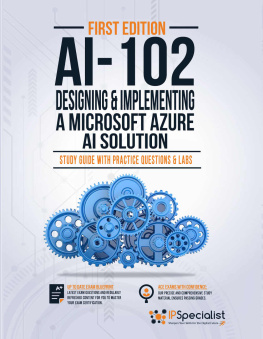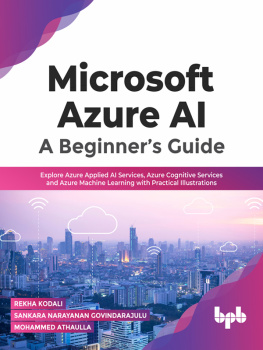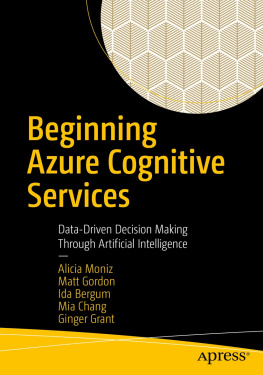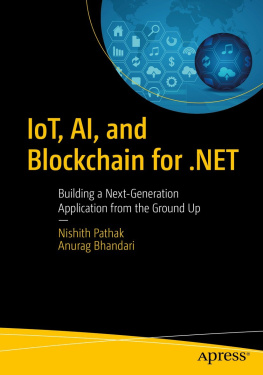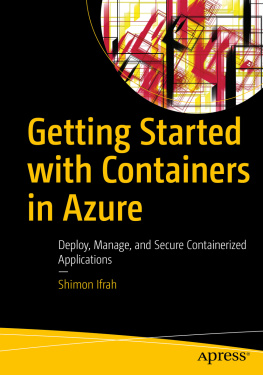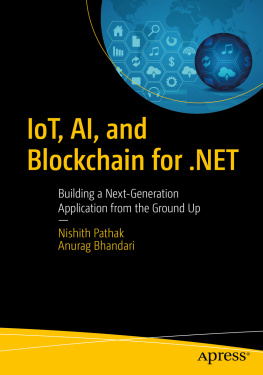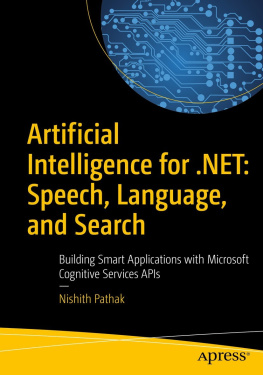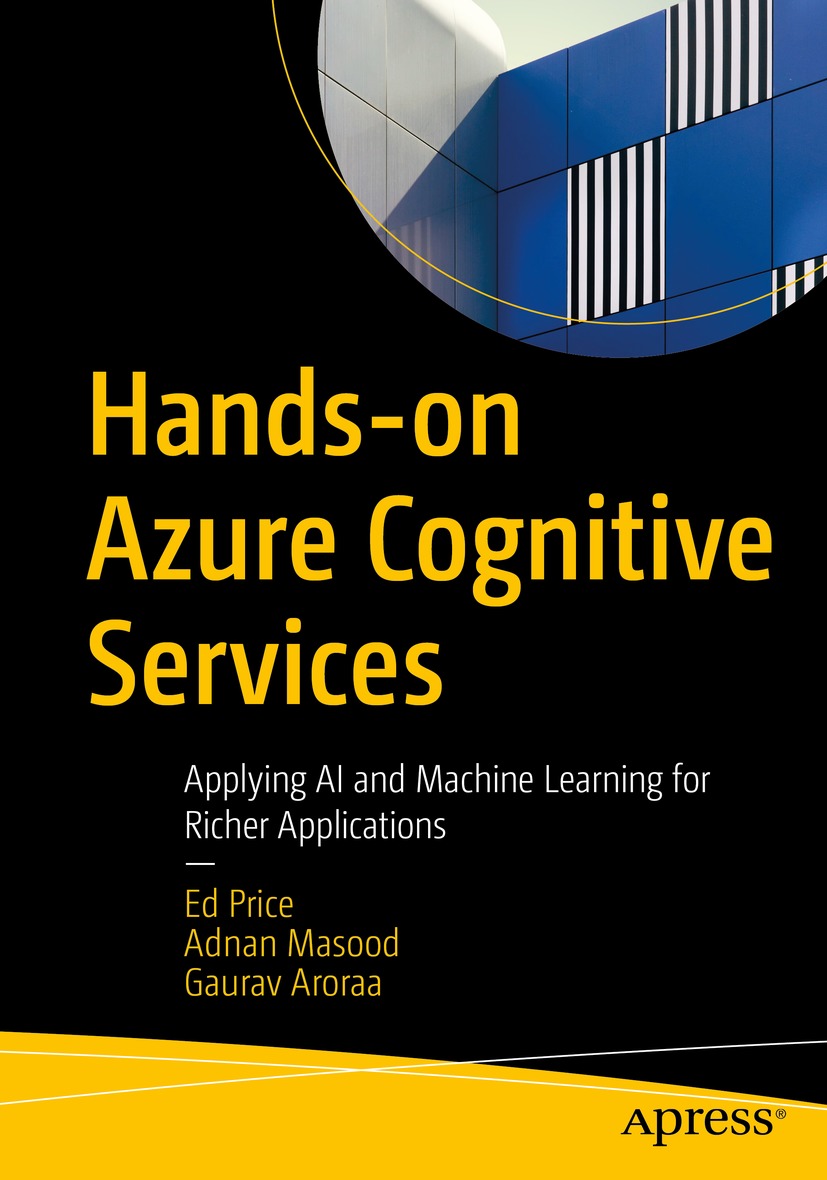Ed Price , Adnan Masood and Gaurav Aroraa
Hands-on Azure Cognitive Services
Applying AI and Machine Learning for Richer Applications
1st ed.

Logo of the publisher
Ed Price
Redmond, WA, USA
Adnan Masood
Temple Terrace, FL, USA
Gaurav Aroraa
Noida, India
ISBN 978-1-4842-7248-0 e-ISBN 978-1-4842-7249-7
https://doi.org/10.1007/978-1-4842-7249-7
Ed Price, Adnan Masood, and Gaurav Aroraa 2021
This work is subject to copyright. All rights are reserved by the Publisher, whether the whole or part of the material is concerned, specifically the rights of translation, reprinting, reuse of illustrations, recitation, broadcasting, reproduction on microfilms or in any other physical way, and transmission or information storage and retrieval, electronic adaptation, computer software, or by similar or dissimilar methodology now known or hereafter developed.
The use of general descriptive names, registered names, trademarks, service marks, etc. in this publication does not imply, even in the absence of a specific statement, that such names are exempt from the relevant protective laws and regulations and therefore free for general use.
The publisher, the authors and the editors are safe to assume that the advice and information in this book are believed to be true and accurate at the date of publication. Neither the publisher nor the authors or the editors give a warranty, expressed or implied, with respect to the material contained herein or for any errors or omissions that may have been made. The publisher remains neutral with regard to jurisdictional claims in published maps and institutional affiliations.
This Apress imprint is published by the registered company APress Media, LLC part of Springer Nature.
The registered company address is: 1 New York Plaza, New York, NY 10004, U.S.A.
Thank you to Adnan and Gaurav for bringing their expertise, passion, and discipline to this book. I dedicate my portion of this book (its probably whatever your favorite part is) to my oldest daughter, Eve. I wrote it when her teenage angstiness hit an all-time high, and she still let me hug her and hang out with her.
Ed
Hi Mom and Dad!
*Waves*
Adnan
My sincere thanks to Ed and Adnan. Without them, this book wouldn't be complete. The year was full of surprises and a lot of struggle throughout the globe. I dedicate this write-up to all the warriors of this era who came forward and helped to save humanity from this pandemic. And to my angel (daughter) Aarchi Arora whose smile always encourages and strengthens me to make me live for this project.
Gaurav
Introduction
In about 400 BC, the Greek tale of Talos was told (and vividly illustrated). It was later chronicled in the epic poem, Argonautica, and its namesake is a giant automaton made of bronze, by Hephaestus, as requested by his father Zeus. This first robot (mythically speaking) sported wings, protected Europa (a woman) in Crete (an island), threw rocks at ships, and met his demise when Medeas spirits drove him crazy enough to pull out his own nail (thus, disassemble himself). In the 300s (BC), Aristotle brought us his syllogistic logic, a deductive reasoning system. Hero of Alexandria applied mechanics, basic robotics, and wrote Automata in the first century AD. AI in robots continued in myths with Pandora, who was also created by Hephaestus (you know, its the story about the box), Pygmalians Galatea (thanks to Venus, this is a statue of a woman who came alive to bear a child; dont ask), and then Jewish lore brought us Golems (in the early 1200s, AD), who are intelligent clay automatons that cannot speak.
Likely, in 1495, Leonardo da Vinci expanded on the many clockmakers mechanical novelties to construct an automaton knight, and in 1515, we believe he continued his efforts to create a walking lion (presented to Francis I, the new King of France, and its said to have been able to open its chest to present the gift of lilies). In 1642, Pascal invented a mechanical calculator. Swifts Gullivers Travels (1726) seemed to have described an engine thats an AI computer and that forces knowledge on the poor Lilliputians. Punched cards came out in 1801, Mary Shelley scared us all with her intelligent Frankenstein in 1818, and in 1884, IBM got its start when Herman Hollerith invented a punched card tabulating machine to conduct the 1890 US census (thats the simplified explanation). At the 1939 Worlds Fair (in New York), Westinghouse unveiled Elektro, the mechanical man (he smoked), and Sparko, his mechanical dog.
Isaac Asimov wrote about robotics in 1950. Walt Disney (after having his Imagineers hack European wind-up novelties) developed a Dancing Man in 1961, he unveiled his tiki birds (which are in the tiki room) in 1963, he also recreated Abe Lincoln in 1963 for the 19641965 Worlds Fair, and he put the first animatronics in film with a bird in 1964s Mary Poppins. Ever since then, as computers evolved, weve been focused on building increasingly improved artificial intelligence in software and robotics (and weve been really hoping that our intelligent creations never take over and destroy us, like in Terminator, Matrix, or even WALL-E).
We intended this book to act as an introduction to Azure Cognitive Services, but also for it to become your guide to implementing Cognitive Services in real-world application scenarios. That means that we take you on a tour of everything that Cognitive Services has to offer, and, as you can imagine, thats quite a journey.
Azure Cognitive Services are broken down into services and APIs that explore decision, language, speech, and vision. With these APIs and technologies, you can create the future software that powers our computers and robots for centuries to come! (Or you can just make a silly website.) In this book, we take you on a journey to build an application, one step at a time. Please join us. After all, youre now walking in the footsteps of Aristotle, Hero, Hephaestus, Rabbi Loew (chief Golem mischief maker), Leonardo (not the turtle), Pascal, Gulliver, Mary Shelley, Hollerith, Elektro, Asimov, Disney, Bill Gates, Steve Jobs, and countless others. Its time to make a creation thats all your own.
Acknowledgments
To Rohit, our technical editor, for being so thorough, meticulous, detailed, careful, conscientious, diligent, scrupulous we are running out of synonyms, but seriously, you rock.
To Shrikant for his extreme patience and regular follow-ups; thank you for putting up with us. Ghosting you is virtually impossible; we tried!
To Smriti for believing in us and this project!
Table of Contents
About the Authors
Ed Price
is Senior Program Manager in Engineering at Microsoft, with an MBA degree in technology management. Previously, he led Azure Globals efforts to publish key architectural guidance, ran Microsoft customer feedback programs for Azure Development and Data Services, and was a technical writer at Microsoft for six years, helping lead TechNet Wiki. Ed now leads Microsofts efforts to publish reference architectures on the Azure Architecture Center (including a strong focus on AI architectures). He is an instructor at Bellevue College, where he teaches design and computer science. At Microsoft, he also helps lead volunteer efforts to teach thousands of students how to code each year, focusing on girls and minorities. Ed is a co-author of six books, including


